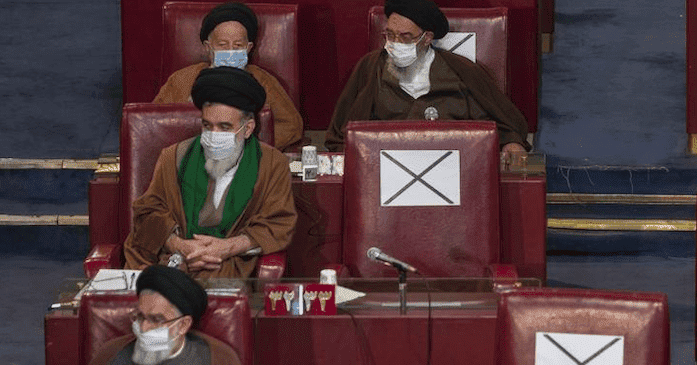In a climate where many clerics are unhappy about their situation and some are losing faith in the Islamic Republic, the purported minutes of a recent regime meeting show how the problem may evolve as domestic unrest continues.
When a document claiming to be the minutes of a January 3 meeting between Supreme Leader Ali Khamenei and senior figures from the Islamic Revolutionary Guard Corps (IRGC) was publicized last week, concerns about the clergy featured prominently in the text. In particular, those in attendance purportedly had much to say about how clerics have been reacting to Iran’s recent protests and the regime’s subsequent crackdown. (For a discussion of the document’s provenance and policy implications, see Part 1 of this PolicyWatch.)
For example, Mahmoud Mohammadi Shahroudi—former head of the Cleric’s Basij, the clerical branch of the IRGC-affiliated militia—was quoted as saying he had never before experienced the problems he was currently seeing, which included unprecedented numbers of clerics engaging in deep ideological confrontation with each other or “leaving the clergy’s sacred uniform” altogether (by his count, as many as 5,000 members of the Clerics’ Basij had left their units in recent months). Some seminary classes had turned into battlefields between students and teachers over the religious justification (or lack thereof) for the regime’s behavior toward protesters. And in many cases, he purportedly argued, seminarians were blaming the judiciary and harshly criticizing Khamenei himself. Shahroudi was then described as warning his audience that “the risk of losing faith in the regime and the Supreme Leader can threaten the regime entirely.”
Regarding the Clerics’ Basij, Shahroudi purportedly argued that the organization is facing “ideological, financial, and local problems.” For one, many clerics no longer felt safe due to the protests, which made it difficult for them to walk in public without being harassed by verbal or physical attacks. He was also said to have complained about clerics’ low income, which forced many of them to take outside jobs. Yet the most “essential problem,” he argued, was the ideological crisis among the clergy, which extended to questioning the Supreme Leader’s legitimacy. Other key officials cited in the document were said to express similar concerns about ideological problems within the clergy and military being exacerbated by the protests.
Clerics leaving the cloth is hardly a unique phenomenon in Iran’s modern history—many young seminarians have made that decision when faced with crises for which they find no satisfactory religious or rational justification, while others have been driven to leave by financial, social, or political motivations. What makes Shahroudi’s alleged remarks stand out is his contention that the problem has grown exponentially since nationwide protests erupted last year.
On the financial front, economic hardship has long been a problem for seminarians because their income is limited to a monthly salary, which can vary greatly depending on how (and how much) their senior religious authorities (marjas) distribute funds. The 1979 revolution drastically changed how the clergy brings in money—whereas they were previously limited to collecting religiously mandated contributions, the creation of the Islamic Republic enabled them to tap innumerable other resources in the state budget and private sector. Yet this newfound wealth has never been distributed equitably among individual clerics, and the religious establishment is generally not committed to ensuring they are treated justly, whether in economic or political terms. As a result, a great number of clerics—especially those who focus on studying in seminaries and have no administrative position in the clerical establishment or government—now find themselves in Iran’s lower classes. As for those individuals who entered the seminary out of financial expectations created by the clergy seizing political power, many now feel disillusioned about their future prospects and thus have little reason to remain clerics.
As for those who leave based on ideological reasons, what has changed is not so much the phenomenon of individual clerics objecting to the views of the establishment and stepping away, but rather the nature of the regime they are reacting against. In the past, hardline elements in the religious establishment tended to oppose any substantial reform, but this opposition was often based on religious factors—that is, their intolerance toward any unorthodox way of thinking or performing as a cleric.
In more recent decades, however, the evolving nature of the Islamic Republic under Khamenei has transformed the clergy’s traditional religious spirit (including its internal disagreements) into something more political, ideological, and totalitarian in nature. The clerical establishment has mutated from a simple, traditional institution into a vast, sophisticated bureaucracy, with all clerics placed under constant ideological surveillance and periodically punished if they overstep the red lines set by the Supreme Leader. In light of this system, and in the absence of any hope for reform, many young seminarians have been leaving the clergy after just a few years, and the number of new students entering seminaries has plunged to new lows.
The establishment has thus been split into two rough strata: those clerics who are direct economic and political beneficiaries of the Islamic Republic, and those who identify themselves as “traditional clergy” and avoid association with the government. The large number of clerics who hold political positions or benefit from state financial support represent the first group; grand ayatollahs such as Ali al-Sistani or Hossein Vahid Khorasani are among the second.
Most members of the “traditional clergy” are deeply concerned about the future of the Shia establishment due to its prevailing image as Iran’s ruling class. Although they do not endorse the regime’s political ideology, its doctrine of velayat-e faqih (which grants the Supreme Leader absolute authority), or its various policies and behaviors at home, they are still reluctant to clearly express different views or stand behind the victims of regime oppression and human rights violations. This relative passivity stems from two main reasons: (1) they do not feel immune to a potential government crackdown given how aggressively the regime has dealt with prominent religious critics in the past (e.g., the late Kazem Shariatmadari and Hossein Ali Montazeri, and (2) they are concerned about what would happen if the Islamic Republic morphs into some type of secular alternative (whether military or democratic), since clerics would stand to lose their historically special status in such a system and be treated like other citizens.
In other words, even as members of the “traditional clergy” criticize the regime for portraying religious figures as the nation’s ruling class and source of legitimacy, they are also unable to countenance a secular form of government in which religious institutions are no longer privileged. The practical consequences of this dilemma have become painfully clear since last fall: the traditional clergy are politically disabled, with no will or means to disassociate themselves from the government and side with the people’s democratic demands.
Going forward, Shahroudi’s alleged comments indicate imminent changes in the fabric of the clergy, especially unemployed seminarians who find themselves excluded from the regime’s benefits. Further securitization of the clerical establishment is also a possibility, which would close any remaining doors to reform and suppress critical voices who may offer provisional remedies for the growing crisis.
Mehdi Khalaji is the Libitzky Family Fellow at The Washington Institute.


